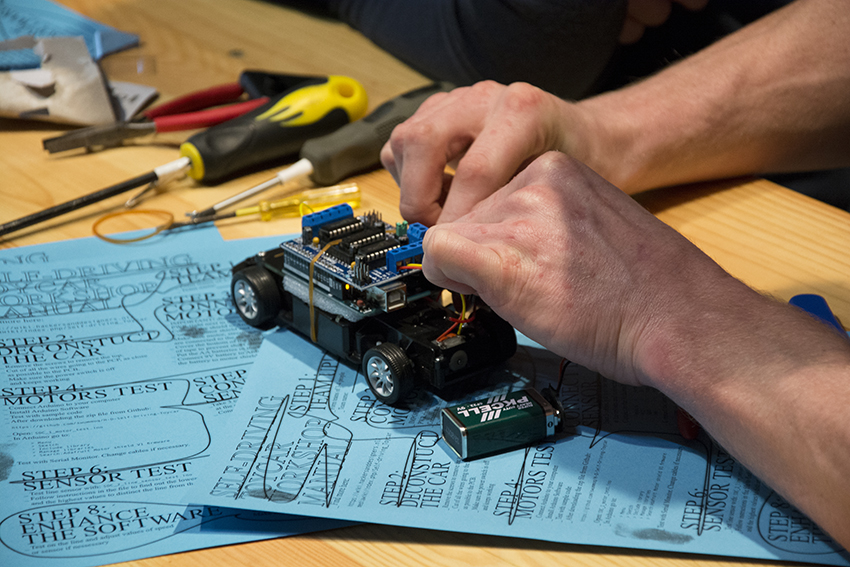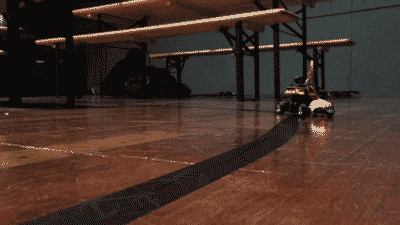Levels of Autonomy
Hackers & Designers aims to create an opportunity to collectively investigate the technologies in and around the self-driving car, discuss and investigate the ethical and philosophical questions that come with our reliance on technology in modern society all the while making a self-made self-driving car. The hands-on approach to learning therefore stays the focus in every workshop. The five ‘levels of autonomy’ (SAE Automated Vehicle Classification based on six different levels) are used as a means to work towards a better understanding of the practical aspects of conceptualising and building a self-driving vehicle. The classification system is based on the amount of driver intervention and attentiveness required and is used as a discursive and communication thread throughout the workshop programs leading towards a DIY self-driving vehicle.
Hackers & Designers has initiated a series of five hands-on workshops with Waag Society and Heerko van der Kooij. On November 8, 2017 Hackers & Designers gave a workshop at Rijkswaterstaat (part of the Dutch Ministry of Infrastructure and the Environment) which was an interesting opportunity to talk about future physical and digital infrastructure with government employers.
The world is changing with a fast pace and the self-driving car is one example of how the future of our cities will be changed drastically. It is hard to grasp technology is accelerating, and influences the way we live together. As urban dwellers we inevitably have some kind of relation to cars. We can however only imagine what the consequences of autonomous vehicles could be and could only give a hypothetical roadmap of how those rolling robots could influence everything around us. Speculating on those consequences is very important in order to create an understanding about the impact self-driving cars will have. It seems difficult to imagine how the wide-ranging challenges around the self-driving car could be solved. However by opening up the conversation with diverse stakeholders H&D attempts to point at, discuss and understand issues that might arise in a public and inclusive manner.
First let’s list the 5 levels of Autonomy (that are actually 6) that are listed on the Autonomous Car wikipedia page:
- Level 0: Automated system has no vehicle control, but may issue warnings.
- Level 1: Driver must be ready to take control at any time. Automated system may include features such as Adaptive Cruise Control (ACC), Parking Assistance with automated steering, and Lane Keeping Assistance (LKA) Type II in any combination.
- Level 2: The driver is obliged to detect objects and events and respond if the automated system fails to respond properly. The automated system executes accelerating, braking, and steering. The automated system can deactivate immediately upon takeover by the driver.
- Level 3: Within known, limited environments (such as freeways), the driver can safely turn their attention away from driving tasks, but must still be prepared to take control when needed.
- Level 4: The automated system can control the vehicle in all but a few environments such as severe weather. The driver must enable the automated system only when it is safe to do so. When enabled, driver attention is not required.
- Level 5: Other than setting the destination and starting the system, no human intervention is required. The automatic system can drive to any location where it is legal to drive and make its own decision.
When talking about self-driving cars, the conversation easily shifts to moral and ethical decisions that the cars would be able to take. You can see on a website of M.I.T. the sorts of moral decisions people are saying that autonomous cars will need to make.
A common example is one that Rodney Brooks brings up on his blog: “When the brakes suddenly fail should the car swerve to miss a bunch of babies in strollers and instead hit a gaggle of little old ladies? Which group should the car decide to kill and which to save, and who is responsible for writing the code that makes these life and death decisions?”
Those moral dilemmas are quite distracting as there is no good answer to them, we as human don’t have the answer when in a similar situation so how could we expect a car to solve this.
An interesting project to explore all the ethical issues around the self-driving car:
The infrastructure changes could become an issue when thinking of future cars.
Let’s imagine at some point we all shift to electric cars, we would all need chargers in front of our houses but after only a few years we might have fully automated cars that can charge on their own. We then would have to destroy all the infrastructure that would have been made before.
During one of our workshops at Rijkswaterstaat a participant said something particularly interesting: “We don’t need all these steps. The cars should simply be smart enough. We then don’t need another infrastructure we just use the same and cars have to figure it out!”
Public workshops were attended by students, makers, artists, people from Rijkswaterstaat and other government employers that are privately interested in this subject, to get more into electronics and building things. The workshop with participants from various departments of Rijkswaterstaat brought up very different opinions, which demonstrates various sides around the topic and simultaneously helps to push the discussion further. This H&D workshop was part of a three day symposium organised by Rijkswaterstaat in order to think of the technical changes that are happening. Car manufacturers like Tesla were there, along with some simulators, and other sorts of workshops and lectures on the topic. The fact the discussion is happening on a governmental level is very important. Even more important is that people like us (citizens) also take part in the conversation, voice opinions and give feedback to be able to influence the research that is mostly based on information from government reports and from the industry.
Hacking toy cars is a first step into reflecting upon this topic. Making something while exploring such a topic changes your perspective on issues as you are suddenly participating in the process and not just undergoing it.
We just propose a few lines of code but still you get an idea of how a machine perceives the world. which is much more abstract than the way humans look at the world.
Another way of seeing the world as a self-driving car.
The workshop starts with each participant getting a toy car in a box. The first thing we do is cut some wires and take everything apart to add our own parts. There’s a lot of interesting things to discover when you have never done something like that before. Real hacking! The initial code is very simple: The car can see grey areas. When sensing black it goes to the side. When sensing white it goes to the other side. It swerves!
Another take on hacking self-driving cars.
The idea that we could implement our own code in the car is seen by some people as dangerous and unsafe. This could however become very important for game changing features. To have some control as individuals – or as a non-so-big-company or non-governmental entity – about what goes into these cars is what we should aim for! If this is done by a commercial party we will have to surrender yet again to some capitalist power structure. Big data companies are getting even more powerful, and that is starting to become (really) scary. We – as citizens – need to find ways to keep technologies in our hands.
Some scenarios are pointing out the dangers of self-driving cars by imagining the possibilities of cyber attacks. It would not make anyone safer if Facebook or Google are writing the code for those cars and we can’t have any access to it.. We want to be able to inspect and to find bugs. If Google owns the softwares of all the cars in the world we have no way to know if it’s safe or not, if it can be hacked or not. You will read about it but you will not be able to participate in the process.
An interesting speculative short story depicts some important questions raised on this aspect.
The big stakes of the industry in the Self Driving Car development is something relevant to point out. Users of the product aren’t central, the stockholders are. We have seen the development of the tech industry in the last years with some constructive outcome along with some very negative side effects. As mentioned in a recent article in The Guardian, tech leaders built advertising engines (Facebook or Twitter ads) as if it could never be used to deliver for example precisely targeted ideological and political messages to voters. One could assume that they knew about the potential dark side all along and simply didn’t care, because to acknowledge it might have undermined their initial goal. These new technologies are often black boxes, one has to guess what’s going on in there and whether it is in the interest of the ‘common’ people. If all these black boxes start driving around it is urgent to develop an understanding of what is going on in there.
During the Rijkswaterstaat workshop we proposed 4 tables with axis. During the hack breaks participants had to position post-it notes on a table depending on their opinions: should the software be open source? or owned by a company? should it be structured by the government? should the car be smart enough to drive by itself? By the end of the workshop we took a closer look at those tables and started a discussion. Surprisingly there were very different ideas: not everyone was going in the same direction.
The workshop at Rijkswaterstaat was an excellent opportunity to pose critical questions at actual stakeholders. The general consensus was, that either the government or Rijkswaterstaat should be in control over the situation. In our circles we tend to think that it should be more open-source and self-organised, there they need norms and regulations and some international organisation that makes all the rules that can then be implemented by each government. It’s very strict.
[images from the workshop / video]
In his blog post “Unexpected Consequences of self-driving cars” Rodney Brooks gives a few tangible examples of everyday life usage of a self driving car. One example: You want to stop at a bakery to buy your bread but can’t find a parking spot. With a fully automated car you could just leave your vehicle to circle around the neighbourhood and call it whenever your are done. That kind of behaviour could be very problematic socially and environmentally and leaves us to wonder if the model of ownership of cars is what will prevail in the future. Shared ownership or cars on subscription could be a better model to distribute the use of those cars.
But maybe we won’t need cars anymore at all!
An interesting quote of Henry Ford on the first automobile: "If I had asked my customers what they wanted, they'd have asked for a faster horse."
Recent news about self-driving vehicles.
the same news from another perspective.
Related Events
23.11.2017 Hack night: Self-driving toycar I at Waag Society
14.12.2017 Hack night: Self-driving toycar II at Waag Society
Make your own self-driving toy car at Today's Art



